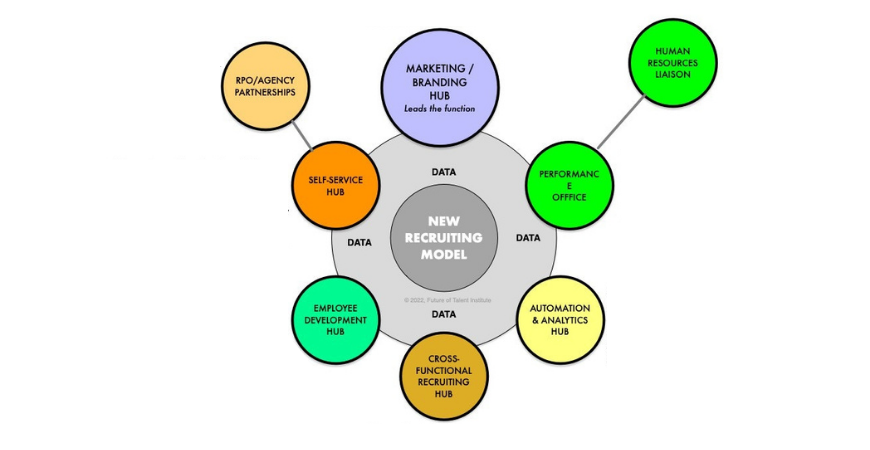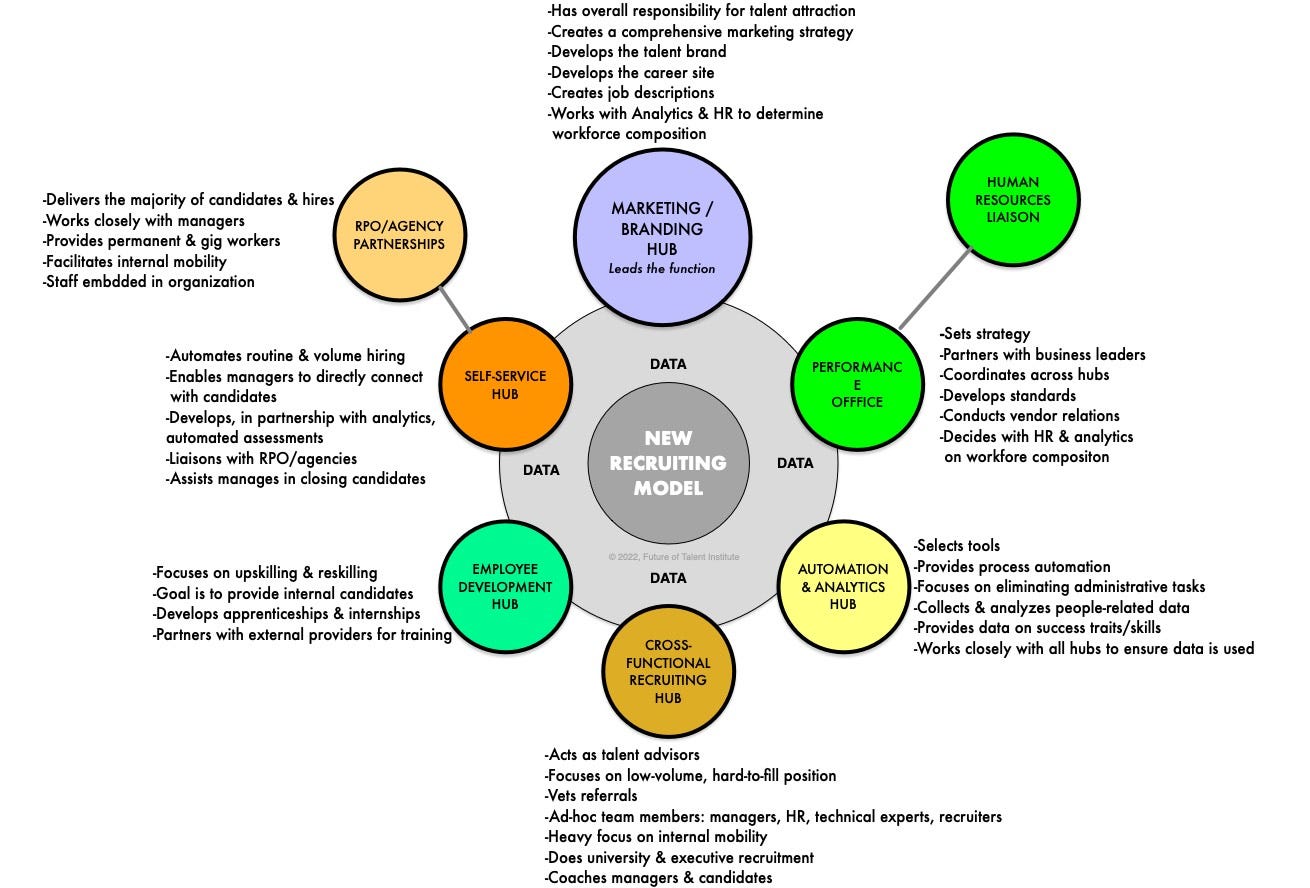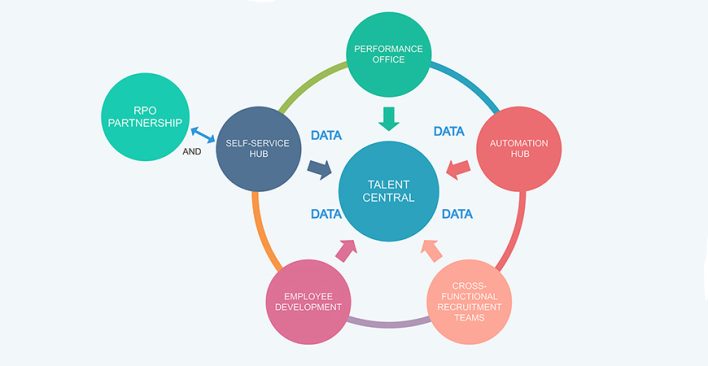A (Revised) Radical New Model for Recruiting

Roughly one year ago, I created a model for reorganizing a recruiting function. I did this in response to the need organizations have to recruit hard-to-find, high-quality talent and their poor performance in doing that.
Today’s recruitment functions act too slowly and often lack knowledge about the business and the skills needed. They have a poor picture of the available talent supply, lack marketing expertise, and hinder efficiency with complex administrative systems. They do not meet the expectations of many candidates or hiring managers accustomed to fast service and prompt feedback.
Recruiting functions are organized for an era that is gone. The current model worked well when skill needs were predictable and the positions that needed to be filled were stable. It worked when the talent supply was generally plentiful and primarily local. But it is clear that this model, a relic of 20th century – manufacturing era organizations, needs to be radically disrupted.
I have updated and modified the model I presented last year to include the feedback I received and emphasize the need for more focused and central marketing and data functions. In one of my recent articles, I advocated for recruiting to become or be part of a marketing function.
The feedback was that recruiting should stand alone, not be part of HR or marketing. I tend to agree. The model below has recruiting as a separate function from HR but with a with marketing component as it’s main driver.
A New Model
Figure 1 lays out the elements that are required for an effective, modern, and agile talent function. (Click the image to enlarge and see in more detail.)
The newly structured function assumes the responsibilities for talent management, recruiting, employee development, and internal mobility. It becomes the overall talent arm of the organization. It is responsible for ensuring the organization can meet skills needs as quickly as they arise. This means that it must be agile and attract all types of talent, whether permanent, freelance, or consultant. And it needs to do this either through its own processes or by utilizing RPOs or other external resources. It must also be continuously aware of emerging skill needs and provide coaching and learning opportunities for internal employees.
I have broken the function into six focus areas, each with its own expertise.
Marketing & Branding Hub
I added this hub to the top of the model to reflect its importance to recruiting. As I stated in a recent article, recruiting is primarily a marketing function and needs a high level of expertise to attract candidates in a talent short and competitive market.
The era of post-and-pray and searching LinkedIn and the internet are no longer adequate. Even a good employment brand is inadequate to attract the best talent.
Organizations need to use the techniques of product marketers to differentiate their jobs, work culture, and other factors from their competition. They need more comprehensive and global talent intelligence and need to target specific types of candidates. Very few current talent functions have the expertise to research and create effective marketing campaigns or build a strong brand. This requires the use of data and creative skills to develop and curate content, develop relationships, build communities, and do all the things required to generate a flow of qualified candidates.
Talent is harder to acquire without independent and robust marketing functions, and many highly skilled people are never seen.
Performance Office
The performance office is the strategy development arm and integrator of the numerous elements needed for a complete talent picture. It is responsible for ensuring the organization has the skills and people to meet any future requirements. It is designed to set standards, negotiate with vendors, use data to decide whether to recruit or develop required skills, work with the automation hub to select tools and integrate them into the various functions, and coordinate activities between the different hubs. It liaises with both the RPO vendors as well as with human resources. The HR liaison is critical to ensure that policies are in alignment.
Automation and Analytics Hub
Since recruiters are not technologists and should not be, and corporate IT functions have other priorities, creating an automation hub makes sense. In such a hub, a team of technicians, analysts, and recruiters work together to select, implement, and continuously improve recruitment tools, the career site, assessment, and the application processes. This relieves recruiters from doing what they lack the expertise to do and provides candidates the experience they expect – quick service, feedback, and prompt decisions.
This hub simplifies and automates the administrative tasks associated with recruitment. Automated tools, powered with artificial intelligence and machine learning, offer candidates a personalized experience with relevant and engaging content. They can also screen and assess candidates and recommend selected candidates for hire with increasing accuracy as more and more data is accumulated and analyzed. These tools can find suitable candidates, communicate with them, and do the administrative tasks associated with hiring.
To enhance the automated tools’ ability to make good decisions and ensure information is available to the recruiting team, there must be the capability to gather and analyze all sorts of data about people. This includes assessing skills, analyzing work patterns, measuring performance, and correlating skills and abilities with the work needed.
Cross-Functional Recruitment Teams
If direct human-to-human contact is necessary, ad hoc recruiting teams formed and disbanded as needed can be charted. They can be focused on hiring a vertical, a unique individual, global hiring, or whatever is required that is not routine or high-volume. Hiring managers become vital team members and take over some of a recruiter’s functions. The team might include a technical expert who would help make sure the selection criteria are appropriate for a position and, of course, a marketing person to create a strategy for attracting the needed talent. This network of allied employees can significantly increase the speed and efficiency of finding and hiring the right people. Only a handful of experienced recruiters are needed as the Self-Service Hub, and RPOs handle most volume recruitment.
Removing artificial barriers and fostering cooperation and sharing among those who formerly worked in functional silos allows people to expand beyond narrowly defined roles, take on new roles, learn, and bring fresh ideas.
Employee Development
Being able to develop talent is an integral part of any talent strategy. An organization needs to analyze the skills of existing talent, assess the availability of the skills it needs in the marketplace, and develop those skills internally and externally when the supply is constrained. Today this function is often separate from recruiting and may not align with it. By integrating recruitment, data analytics, and development, the organization can proactively find ways to accelerate skill development. The organization can offer apprenticeships, internships, and rotations to build internal talent, which lessens external recruiting.
Self-Service Hub
Self-service tools provides the organization with a fast and effective way to hire many employees. Effective marketing will attract candidates and combined with straightforward job and accurate skill criteria; it can assess candidates using variously accredited online tools. Hiring managers can choose from a vetted list of candidates. Other tools can generate offer letters, employment contracts and do all other administrative requirements.
Giving candidates and managers an option to use these tools would be the first step to an automated recruitment capability. There are only a few cases where we need extensive human-to-human direct contact. The majority of open positions can be filled quickly if we have good marketing and data-driven assessment. It is only logical that in an increasingly self-service and automated world, we allow candidates and hiring managers to find each other and communicate without any recruiter involved.,
Of course, there are variations on this model that may suit one organization better than another. I understand that this model would only be possible in a large firm, but some the same ideas can be modified for smaller firms. Automating high-volume recruiting may be a challenge but would almost immediately relieve recruiters of the administrative tasks and volume overload they face. It would allow them to engage with the business in more meaningful and strategic ways.
The key message is that those firms that attract the best talent will enjoy a competitive edge. This will not happen given the current recruiting functions’ administrative and tactical structure.
This article originally appeared in the Future of Talent Newsletter and has been republished here with permission.
Related articles
Sign up to our newsletter
Get a weekly digest on the latest in Talent Acquisition.
Deliver this goodness to my inbox!




Comments are closed.